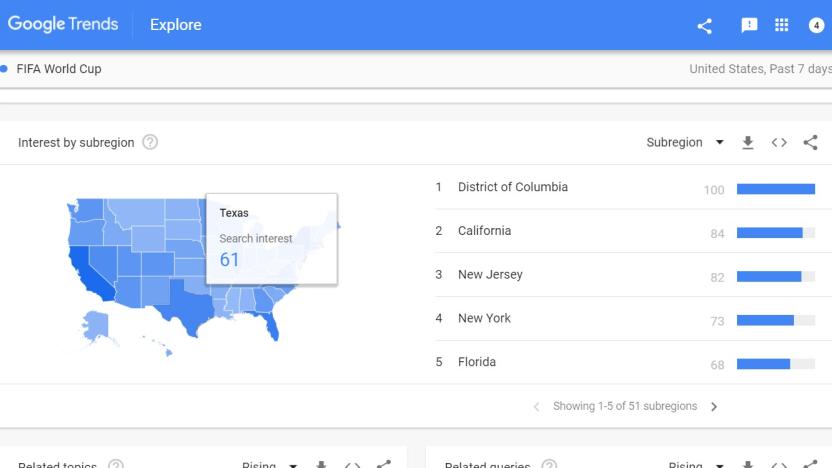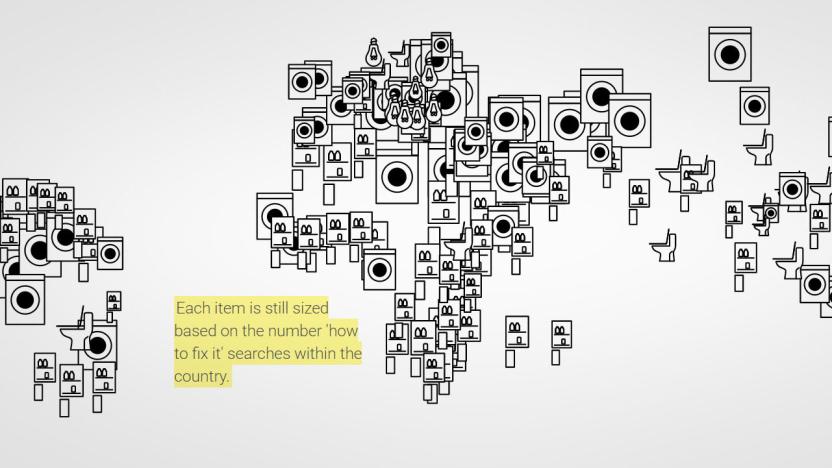trends
Latest

The Weather Channel brings localized COVID-19 updates to your phone
The Weather Channel and its parent company IBM (yep, who knew?) have teamed up to bring coronavirus data, maps and charts to your phone. They're importing data from sources like the World Health Organization (WHO), and including info from reliable local and state sources, so you can get a picture of how the virus is spreading near you, across the country and around the globe.

Why are people pretending to be dead on Instagram?
Ahmed Simrin, 15, is one of the millions of teenagers who uses Instagram. He doesn't post pictures on his page every day (there are two total), yet somehow he's managed to get nearly 3,000 people to follow it. That doesn't make him a social media influencer, by any means, but his Instagram page quickly stands out when you realize one of the photos has over 22,000 comments and 4,000 likes. This type of engagement is typically only seen on accounts from celebrities. His viral picture, posted in October 2017, isn't anything out of the ordinary, either: It's Simrin simply standing next to his friend, each staring directly into the camera, with a caption that reads "Fresh out the oven." But then you look at the comments, and it would appear that poor Simrin is no longer with us. There are thousands of users telling him to rest in peace. "RIP, you'll be missed." "RIP, bro." "You died way too young." "I can't believe you're gone." The list goes on and on.

Google Trends redesign focuses on finding stories in the data
Remember Google Trends? The site that keeps you up to date on what the world has been searching for just got a makeover. According to the team, this redesign puts "more editorial data-based stories up front," along with a section featuring data stories picked out by a news team. You can easily check out the Year in Search dating back to 2001, while an intensity map can show where searches were popular by country or individual state. The easy-to-create topics and infographics are supposed to help news organizations sift through the available data, so don't be surprised if you see more stories based on trends.

Google offers real-time search data for news, images and video
Finding out what people are searching for in real time is a trivial matter these days, thanks to Google Trends. Online since 2015, the service is useful for discovering what the world is paying attention to, like why Donald Trump was elected last November or which Halloween costume will be the most played out. Heck, Mac users can even get a screensaver to visualize searches as they happen. Now Google is exposing even more of its real-time data to include news, images, video and even shopping results in your topical search area.

Google reveals its most-searched ‘How To’ tips
It's easy to forget how difficult DIY repairs were just a couple of decades ago, considering how easy the internet makes it to fix very specific product problems. (My biggest personal victory was fixing a 50-inch LG plasma display that borked a week after the warranty expired, following some extensive Googling.) Now, Google has created a site that shows exactly what you want to fix, do and learn the most, based on where you live.

Google knows which words you have trouble spelling
To celebrate the culmination of Scripps' National Spelling Bee, Google decided to find out what words most Americans struggle with. The search engine aggregated every query that began with "how to spell" and then identified which one was the most popular in each state. Surprisingly, "diarrhea" isn't the word most people struggle with, which is "desert" and / or "cancelled," depending on where you live. Other terms that have users stumped include "neighbor," "vacuum," "gray" and "pneumonia" -- the latter of which is a preoccupation for the folks in Washington State, Missouri and North Carolina. We're not sure that the results say anything meaningful except to make us wonder why Utah and Arkansas are so preoccupied with leprechauns. Oh, and people who live in Massachusetts don't know how to spell Massachusetts. Here's a tip, then: It's spelled Massachusetts.

Happy third birthday, Vine, here's what's trending
Vine celebrates its third birthday on January 24th, and in just three years the platform has become a cornerstone of pop culture. These days, memes just don't happen unless they got their start on Vine, and the service is embracing its reputation as a taste maker. That's why the Twitter-owned network is launching Trends on Vine, a site that enables you to keep up with what the kids are doing -- without having to sit through all those Curtis Lepore clips. In addition, the outfit has revealed the five most popular trends of Year Three, as well as the clips that inspired them.

YouTube's 2015 Rewind brings you cage dancing and gamers
YouTube may not be the first internet giant to serve up a year-end retrospective this week, but it's making up for that in style. The video service has posted the 2015 edition of its annual Rewind video recapping the year's trends, and this one pays an ode to more than just the usual internet celebrities and viral clips. On top of mainstays like iJustine and Rhett & Link, the look-back also includes gaming stars like Markiplier (on the left) -- a plug for YouTube Gaming, to be sure, but also a tribute to the rise of Let's Play videos. You'll get your fair share of dancing, too, whether it's in a cage or in retro clothing.

CDC: Nearly half of American homes no longer have landlines
The Centers for Disease Control and Prevention (CDC) released a new survey Tuesday, showing that nearly half of all American households now use only cell phones rather than older landlines. In total, 47 percent of the 21,000 households queried were cell-only, 41 percent use both, just 8 percent use just a landline, and 3.4 percent have no phone at all. Accounting for demographics, the results are even more staggering -- 71 percent of 24-34 year-olds use only their cells. Additionally, renters were far more likely to not have landlines than landlords and people living with non-family members went cell-only 85 percent of the time.

IBM's supercomputer knows what'll be hot this holiday
After elbowing its way into hospitals and restaurants, it was inevitable that IBM's supercomputer would turn its attention towards the retail business. IBM has launched Watson Trend, a service that harnesses Watson's deep learning smarts in order to discover the hottest and most desirable products to buy this holiday season. The machine will work out what's hot (and what's not) by trawling the web, looking through everyone's public conversations on social media, blog posts and product reviews. Once the information has been found, it'll run sentiment analysis to determine how people really feel about their new smartphones, TVs and tablets to work out the ones folks love the most.

Google wants you to follow hot search trends in real time
Never mind waiting until after the fact to find out what people are searching for online -- Google wants you to know what's hot right fricking now. The internet giant has introduced real-time tracking to Google Trends, so you can follow a search frenzy as it happens. If you want to know which basketball team is dominating the buzz over the past hour (spoiler: it's the Golden State Warriors), you just have to narrow the scope accordingly to see a minute-by-minute graph. The trend page has also been redesigned to put a bigger emphasis on the latest stories, and you can dive deeper into niche subjects and specific regions. Yes, you're still looking at charts, but this refresh at least gives you a good excuse to visit Google Trends more than once in a blue moon. [Image credit: AP Photo/Virginia Mayo]

Google Maps gets even more detailed traffic features
Google has updated Maps with more specific traffic alerts just in time to help you dodge Memorial Day traffic nightmares. The app can already route you around closures and other problems using crowdsourced traffic data, but now it'll give you an explanation for why a detour is recommended with a dismiss-able card. For instance, it'll let you know whether it's recommending a route because it's the fastest option, or because it helps you avoid an incident. Moreover, it'll now give you a heads up on traffic conditions as soon as you enter your destination, telling you if its smooth sailing ahead or a cluster-you-know-what.

Twitter revamps trends to explain why a topic is popular
Peeking at what's trending on Twitter ensures you don't miss anything, but sometimes a hashtag's meaning isn't obvious. For those strange-looking acronyms, subjects and unfamiliar names, the 140-character social network tweaked the way its Android and iOS apps handle trends. On the top chart, there are descriptions for each item that not only decodes a hashtag, but explains why the subject is a hot topic. The company nixed the Discover and Activity tabs too, and all the details on what's popular now reside in Search. Unfortunately, the new workflow is only available on mobile in the US for now, but it'll arrive in more locales, and on the desktop, "in the future." Revamped trends follows the recent change to quote retweets so that they don't eat up that valuable character allotment -- both of which make Twitter's own software more attractive.

Google Trends email alerts will guarantee you never miss another cat meme
You can always swing by Google Trends if you want to gauge the popularity of a given search, but visiting that website every time can be a hassle. Thankfully, there's now an easier way: Google has added a subscription option that sends email notifications when there are changes in the interest levels for most searches, including hot searches, specific topics and the top US charts. If you want to see how long an internet meme survives or find out when your favorite team is creating a lot of buzz, you just have to visit Trends' subscription area to get started.

Crowdfund Bookie, March 2014: The slide continues
The Crowdfund Bookie crunches data from select successful Kickstarter and Indiegogo campaigns that ended during the month and produces pretty charts for you to look at. In case there was any hope that the crowdfunded video game space was on the verge of climbing out of its current slump, the projects that ended in March killed it. Crowdfunding projects during the month raised $991,113 collectively, the second-worst month of funding of the previous ten (January being the lowest that our data provides). A whopping $510,550 was pledged beyond March's funding goals, over half of the total amount raised. The decreasing trends in the space that began in December carried on through March. For starters, 22 projects received funding, which is just above January's 20 and February's 16 projects. March was also second to January in terms of the lowest number of backers in the last ten months, as just 28,460 people showed up to fund video game projects. To put this in perspective, here are three games that each had more backers than the entire month of March: Mighty No. 9 (67,226), Kingdom Come: Deliverance (35,384) and Massive Chalice (31,774). The more telling figure is March's average pledge per person amount: $34.82, the lowest of any month since we began tracking crowdfunding data. What's more, two games saw inordinately large averages, Oscar ($175.37) and BasketWars ($366.18). Without those two projects, March would have sported an average pledge of $33.44. By comparison, the average pledge during the winter quarter $44.26 and backers during the previous six months ponied up an average pledge of $47.78. The data here indicates one notion (albeit a dangerously simplified one): People are spending less on Kickstarter and Indiegogo in the video game space these days. Head past the break to see the month's breakdown by genre and a list of its top five projects.

GDC: Industry talent favors PS4 development, self-publishing
The Game Developers Conference has released the results of its second annual State of the Industry survey, highlighting trends toward self-publishing and PlayStation 4 platform development. More than 2,600 developers responded to the survey following last year's GDC event, with twenty percent noting an intent to ship their next project for the PlayStation 4. Seventeen percent of surveyed developers foresee an Xbox One release for their next game, while four percent target the Wii U. Smartphones and PC platforms continue to dominate developer focus, however. According to the GDC's survey, 51 percent of respondents want to make their next game for tablets and smartphones, while 52 percent will tackle PC and Mac platforms. This year's survey also revealed a rise in self-publishing and self-funding among developers. 64 percent of surveyed developers reported that they are not partnering with a publisher on their current project, while 52 percent revealed that existing company funds provided financial backing. More developers have turned to Kickstarter since last year's survey, as 11 percent of respondents are crowdfunding their current projects, compared to last year's 4 percent. [Image: Sony]

Free for All: The rising cost of early access and exclusivity
Here I sit, waiting to log into Aura Kingdom, a new Anime MMO by Aeria Games. The beta I am going to log into is the Founder's Beta, an exclusive early-access pre-closed beta that had an entrance fee starting at $19.00 and topping out at $299.00. Yes, 300 US dollars. I'm not trying to appear judgmental in my emphasis, but I do think that this provides more proof to the theory that prices for virtual items are continuing to climb. And why shouldn't they? I've talked before about selling power and how its slow climb will likely not stop. Just like selling exclusive or early access, selling powerful, useful in-game items most likely makes money. Something like a Founder's Pack offers useful in-game items and exclusivity, a very tempting concoction that many find too hard to resist. Is it fair to offer early access for such a price, and will other titles have to respond to the success of such sales by creating their own?

Twitter acquires Trendrr to bolster real-time coverage of TV trends
If it wasn't already clear that Twitter is serious about monitoring TV trends, the company just proved it by acquiring Trendrr. The deal gives Twitter new tools for both tracking social network activity during TV broadcasts and delivering that information to advertisers and media producers. While the two companies aren't specific regarding their plans, Trendrr is scaling back its operations: its Curatorr service will keep going, but it will stop taking customers for its Trendrr.TV engagement tracker. It will be some time before we see the results of the acquisition, but the increasingly tighter links between Twitter activity and TV suggest that the buyout could prove worthwhile in the long run.

Facebook unveils Trending Topics, makes Graph Search available everywhere in US English
Facebook must be a little envious of Twitter's ability to seize on trends -- it just started experimenting with Trending Topics, a Timeline card that shows the hottest subjects on the social network. Users can tap a trend to see both public comments and posts, whether or not the contributors are friends. The service is only being tested with a small number of those using Facebook's mobile website right now. If you're too impatient for that, the company has a consolation prize: Graph Search is now available to everyone visiting the site in US English, regardless of where they live. The expansion comes with the end to a handy privacy tool that lets members see who can search their Timeline, but Facebook claims that few have been using this feature -- we shouldn't miss it too much.

SwiftKey Cloud syncs your keyboard profile, includes trending phrases (video)
Here's something we've all been wanting for some time. SwiftKey Cloud is launching today with a bunch of new functionality including -- you guessed it -- cloud backup and synchronization across multiple devices. By keeping your keyboard profile and settings online, you no longer have to re-teach Swiftkey your typing habits if you upgrade to a new tablet or lose your phone. Trending phrases is another new feature which analyzes relevant and localized phrases that are trending on social networks and other media and adds them daily to the keyboard's vocabulary. It supports US / UK English and eleven other languages at launch, with more coming in the future. Finally, SwiftKey Cloud makes its easier than before to personalize your keyboard by connecting it with your GMail, Facebook, Twitter and now Yahoo! mail accounts. We've been using the beta for about a day now and everything's working as advertised. Check out the gallery below, then hit the break for the promo video and PR. %Gallery-194389%












